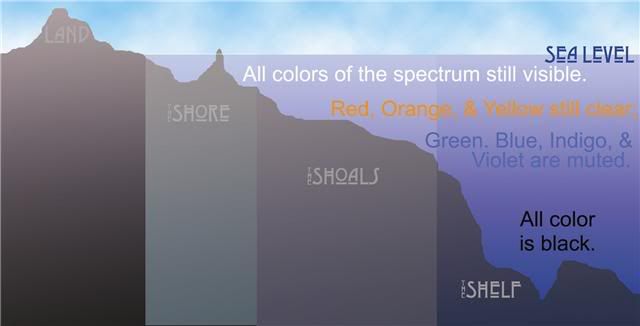
Topographical zones
Despite its submergence beneath fathoms of water, Elqua is little different from any other world. It has mountains and valleys, rolling hills and wide plains, shallow basins and expansive mesas. The main difference between the more familiar world and the world of endless blue is that Elqua’s ocean level is far higher than most. The tallest peaks of mountains in a normal realm appear as island archipelagos here, and what would be sea level for a more familiar world becomes a kind of underwater balcony before the drop into the darkness of the ocean floor.
Understanding the logistics of Elqua requires the acceptance that the oceans are comprised of three levels, layers that cut across the depths of the world’s water: the Shore, the Shoals, and the Shelf.
The first layer is known as the Shore, and it is composed of the sea floor that directly touches land at the water’s edge and extends approximately 200 feet from the surface. Usually defined as “lit water”, the visible spectrum of light fully illuminates this layer along the coast of what little land breaks the waves. Wildlife of vivid and varied color thrive as the Sun warms these waters thoroughly, allowing more traditional ecosystems to continue and flourish, and as such surface predators use these coastal areas as hunting grounds. This area includes the waterline gained and lost by the complex tides of Elqua.
Next come the Shoals, or “dark water”. This far down – to about 650’ – ambient light has begun to be absorbed by the expanse of water above. Cooler colors begin to look muted and muddy, and the warmer colors are little more than black. Shades and hues become washed out and indistinguishable. With less light, the water is cooler here, and requires a modicum of protection to withstand the temperature. The land begins to slant downward more aggressively, and can extend outward this way for miles and miles in all directions. The sea floor here would be the equivalent of the plains on a dryer world, ie, large swaths of relatively flat land for as far as the eye can see. The majority of life on Elqua inhabits this zone.
Finally is the Shelf. Light has all but been swallowed up, and normal vision is useless. Darkness is the norm here, and due to the complications of maintaining life at these depths, the few races that live here are the more varied and extreme. Insulated from the heat of the sun, significant adaptation must be made to avoid hypothermia. Here the continental plates take a sharper slope downward, forming the trenches and basins of the deepest oceans.
The races of the Endless Blue setting are scattered across these striped regions. Some, like the Kouton, are tied closely to the Shore due to biological need. Others, such as the Orcans, populate the Shelf almost exclusively. Then there are the Ceph, whom are found everywhere, in a manner reinforcing the ancient bigotry that they are essentially vermin that have worked their way into every hidden nook and cranny of decent Elquan life.
Travel
Even a basic grasp of geography would tell you the shortest route between two points is a straight line. While this is difficult to accomplish above water due to the curvature of solid land, it is much easier to achieve under the waves.
The seafloor is much like a valley, but on a vastly larger scale. The tips of the hills would be the Shore, the slope of the hills the Shoals, and the valley bottom itself the Shelf. Short of some kind of magic, to travel from hilltop-to-hilltop on dry land requires a traveler to climb down one embankment, hike across the valley bottom, and then scale up the opposite slope. But underwater, the inherent tendency for matter to float (called buoyancy) allows travelers to simply swim straight across from hilltop-to-hilltop, avoiding the valley altogether.
However, there are dangers to this. Foremost among them is “water blindness”. Due to the light-absorbing properties of water and the particulate matter suspended therein, vision is often limited. While in the Shores land is almost always visible, floating above the center of the hypothetical valley may put hilltops beyond visual range. With no point of reference, it is quite easy to become disoriented and lose one’s way. Even rising to the surface is of little help in mid-ocean, where the endless horizon of rising and falling waves is rarely broken by a glimpse of land.
The next danger is the vulnerability. With solid earth firmly beneath your feet, it is generally a safe assumption that nothing will burst up out of the ground and swallow an unwary traveler. However, when afloat in the water, danger can approach in not just the hemisphere above, but from below as well. With 360o cube degrees of potential danger, it makes crossing “open waters” a risky endeavor.
The risk of cross-currents adds to the difficulty of travel. While a body of water may appear as a languid pool, the flow of water layers can work against passage, dragging the helpless victim at immense speeds into danger. These currents can be as weak as a trickle, or as strong as raging river rapids. And when submerged in total water, visually discerning these tidal forces is nearly impossible as they are for all intents invisible to simple sight. The development of infravision – seeing into the infrared spectrum normally given off by heat – has allowed some creatures to deal with this ever-present and quickly changing threat.
Finally, there is the effect environmental space has on the size that lifeforms can theoretically achieve. With more space, creatures that normally would be expected to grow to a moderate size – like say a squid – can grow to a colossal scale. With the volume of the oceans on Elqua, there is no gauging to what extremes a creature might reach. Larger predators that may move faster, swim deeper, and consume huge groups of Pisceans like they were microscopic plankton. Even animals thought as harmless due to their normal diminutive size become hazardous threats when their scale is multiplied by a magnitude or two.
In general, it is safer to skirt along the seabed when traveling. It provides protection in the form of shelter and opportunities to hide that are simply impossible floating in the middle of the deep blue. On the other hand, there are some risks in traveling along the ocean floor. Traveling too deep runs the risk of dangers from ocean pressure – the weight of all that water overhead pressing down on a creature. The deeper one sinks, the greater the weight pressing down on their body. If they are not designed to resist these heightened pressures, the creature will literally be crushed from the forces.
Life beneath the waves of Elqua is difficult, but manageable. It takes a different mindset to view what would normally be a boundary for a landwalker as the opportunity it is to a waterdiver. The sharp, straight borders of our world are replaced with the gradual phasing of darkness, pressure, and cold. But despite all this, societies flourish under the seas of the Endless Blue.






No comments:
Post a Comment